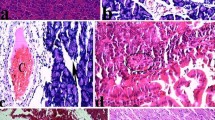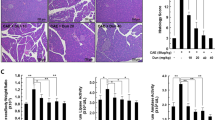Abstract
Reactive oxygen radicals, pro-inflammatory mediators and cytokines have been implicated in caerulein induced acute pancreatitis. Nordihydroguaiaretic acid (NDGA), a plant lignin, has marked anti-inflammatory properties. The present study aimed to investigate the possible protective effect of NDGA against caerulein induced pancreatitis. Acute pancreatitis was induced by intraperitoneal administration of eight doses of caerulein in male swiss albino mice. NDGA was administered after 9 h of acute pancreatitis induction. Pancreatic damage and the protective effect of NDGA were assessed by oxidative stress parameters and histopathology of pancreas. The mRNA expression of heat shock proteins (DNAJ C15 and HSPD1) was examined by real-time RT-PCR analysis. Expression of HSP 27, NF-κB, TNF-α, p-p38, Bcl-2, p-PP2A, procaspase-3, caspase-3 and histone modifications were examined by western blotting. NDGA attenuated the oxidative stress, led to increased plasma α-amylase and decreased IGF-1 in AP mice. It modulated the mRNA and protein levels of heat shock proteins and reduced the expression of NF-κB, TNF-α and p-p38. It increased the number of TUNEL positive apoptotic cells in the pancreas of AP mice. In addition, NDGA prevented the changes in modifications of histone H3 in acute pancreatitis. To best of our knowledge, this is the first report which suggests that NDGA prevents the progression of acute pancreatitis by involving alteration of histone H3 modifications and modulating the expression of genes involved in inflammatory/apoptotic cascade, which may be responsible for decreased necrosis and increased apoptosis in this model of acute pancreatitis.







Similar content being viewed by others
Abbreviations
- AP:
-
Acute pancreatitis
- NDGA:
-
Nordihydroguaiaretic acid
- ROS:
-
Reactive oxygen species
- NF-κB:
-
Nuclear factor-κB
- TNF-α:
-
Tumour necrosis factor-α
- SOD:
-
Superoxide dismutase
- GSH:
-
Reduced glutathione
- TBARS:
-
Thiobarbituric acid reactive substrate
- PP2A:
-
Protein phosphatase 2A
- IGF-1:
-
Insulin-like growth factor 1
References
Bhatia M, Wong FL, Cao Y et al (2005) Pathophysiology of acute pancreatitis. Pancreatology 5:132–144
Tamizhselvi R, Sun J, Koh YH, Bhatia M (2009) Effect of hydrogen sulfide on the phosphatidylinositol 3-kinase-protein kinase B pathway and on caerulein-induced cytokine production in isolated mouse pancreatic acinar cells. J Pharmacol Exp Ther 329:1166–1177
Shi C, Andersson R, Zhao X, Wang X (2005) Potential role of reactive oxygen species in pancreatitis-associated multiple organ dysfunction. Pancreatology 5:492–500
Bokoch G, Knaus U (2003) NADPH oxidases: not just for leukocytes anymore. Trends Biochem Sci 28:502–508
Masamune A, Watanabe T, Kikuta K, Satoh K, Shimosegawa T (2008) NADPH oxidase plays a crucial role in the activation of pancreatic stellate cells. Am J Physiol-Gastrointest Liver Physiol 294:G99–G108
Kim SY, Kim TB, Moon KA et al (2008) Regulation of pro-inflammatory responses by lipoxygenases via intracellular reactive oxygen species in vitro and in vivo. Exp Mol Med 40:461–476
Li N, Karin M (1999) Is NF-kappaB the sensor of oxidative stress? FASEB J 13:1137–1143
Escobar J, Pereda J, Arduini A et al (2009) Cross-talk between oxidative stress and pro-inflammatory cytokines in acute pancreatitis: a key role for protein phosphatases. Curr Pharm Des 15:3027–3042
Arasaki K, Tani K, Yoshimori T, Stephens DJ, Tagaya M (2007) Nordihydroguaiaretic acid affects multiple dynein-dynactin functions in interphase and mitotic cells. Mol Pharmacol 71:454–460
Lee CH, Jang YS, Her SJ, Moon YM, Baek SJ, Eling T (2003) Nordihydroguaiaretic acid, an antioxidant, inhibits transforming growth factor-[beta] activity through the inhibition of Smad signaling pathway. Exp Cell Res 289:335–341
West M, Mhatre M, Ceballos A et al (2004) The arachidonic acid 5-lipoxygenase inhibitor nordihydroguaiaretic acid inhibits tumor necrosis factor activation of microglia and extends survival of G93A-SOD1 transgenic mice. J Neurochem 91:133–143
Goetzl EJ (1980) A role for endogenous mono-hydroxy-eicosatetraenoic acids (HETEs) in the regulation of human neutrophil migration. Immunology 40:709–719
Ito H, Ueda H, Iwamoto I et al (2004) Nordihydroguaiaretic acid (NDGA) blocks the differentiation of C2C12 myoblast cells. J Cell Physiol 202:874–879
Youngren JF, Gable K, Penaranda C et al (2005) Nordihydroguaiaretic acid (NDGA) inhibits the IGF-1 and c-erbB2/HER2/neu receptors and suppresses growth in breast cancer cells. Breast Cancer Res Treat 94:37–46
Ansar S, Iqbal M, Athar M (1999) Nordihydroguairetic acid is a potent inhibitor of ferric-nitrilotriacetate-mediated hepatic and renal toxicity and renal tumour promotion in mice. Carcinogenesis 20:599–606
Floriano-Sánchez E, Villanueva C, Medina-Campos ON et al (2006) Nordihydroguaiaretic acid is a potent in vitro scavenger of peroxynitrite, singlet oxygen, hydroxyl radical, superoxide anion and hypochlorous acid and prevents in vivo ozone-induced tyrosine nitration in lungs. Free Radic Res 40:523–533
Yam-Canul P, Chirino YI, Sánchez-González DJ et al (2008) Nordihydroguaiaretic acid attenuates potassium dichromate-induced oxidative stress and nephrotoxicity. Food Chem Toxicol 46:1089–1096
Rillema JA (1984) Effect of NDGA, a lipoxygenase inhibitor, on prolactin actions in mouse mammary gland explants. Prostaglandins Leukot Med 16:89–94
Ryan CJ, Zavodovskaya M, Youngren JF et al (2008) Inhibitory effects of nordihydroguaiaretic acid (NDGA) on the IGF-1 receptor and androgen dependent growth of LAPC-4 prostate cancer cells. Prostate 68:1232–1240
Meyer GE, Chesler L, Liu D et al (2007) Nordihydroguaiaretic acid inhibits insulin-like growth factor signaling, growth, and survival in human neuroblastoma cells. J Cell Biochem 102:1529–1541
Sandoval J, Pereda J, Rodriguez JL et al (2010) Ordered transcriptional factor recruitment and epigenetic regulation of tnf-α in necrotizing acute pancreatitis. Cell Mol Life Sci 67:1687–1697
Bhaumik SR, Smith E, Shilatifard A (2007) Covalent modifications of histones during development and disease pathogenesis. Nat Struct Mol Biol 14:1008–1016
Kouzarides T (2007) Chromatin modifications and their function. Cell 128:693–705
Mazzon E, Genovese T, Di Paola R et al (2006) Effects of 3-aminobenzamide, an inhibitor of poly (ADP-ribose) polymerase, in a mouse model of acute pancreatitis induced by cerulein. Eur J Pharmacol 549:149–156
Reif AE, Nabseth DC (1962) Serum amylase determination by Somogyi’s amyloclastic method with use of photometric end point. Clin Chem 8:113–129
Mullane K, Kraemer R, Smith B (1985) Myeloperoxidase activity as an assessment of neutrophil infiltration into ischemic myocardium. J Pharmacol Methods 14:157–167
Kono Y (1978) Generatin of superoxide radical during autoxidation of hydroxylamine and assay of superoxide dismutase. Arch Biochem Biophys 186:189–195
Ellman GL (1959) Tissue sulfhydryl groups. Arch Biochem Biophys 82:70–77
Ohkawa H, Ohishi N, Yagi K (1979) Assay for lipid peroxides in animal tissues by thiobarbituric acid reaction. Anal Biochem 95:351–358
Tikoo K, Meena RL, Kabra DG, Gaikwad AB (2008) Change in post-translational modifications of histone H3, heat-shock protein-27 and MAP kinase p38 expression by curcumin in streptozotocin-induced type I diabetic nephropathy. Br J Pharmacol 153:1225–1235
Villagra A, Cheng F, Wang HW et al (2009) The histone deacetylase HDAC11 regulates the expression of interleukin 10 and immune tolerance. Nat Immunol 10:92–100
Gomez G, Lee HM, He Q, Englander EW, Uchida T, Greeley GH Jr (2001) Acute pancreatitis signals activation of apoptosis-associated and survival genes in mice. Exp Biol Med 226:692–700
Rakonczay Z Jr, Takacs T, Boros I, Lonovics J (2003) Heat shock proteins and the pancreas. J Cell Physiol 195:383–391
Chen X, Ji B, Han B, Ernst SA, Simeone D, Logsdon CD (2002) NF-kappaB activation in pancreas induces pancreatic and systemic inflammatory response. Gastroenterology 122:448–457
Williard DE, Twaita E, Yuan Z, Carter B, Samuel I (2010) Nuclear factor kappa B-dependent gene transcription in cholecystokinin- and tumor necrosis factor stimulated isolated acinar cells is regulated by p38 mitogen-activated protein kinase. Am J Surg 200:283–290
Bhatia M (2004) Apoptosis versus necrosis in acute pancreatitis. Am J Physiol Gastrointest Liver Physiol 286:G189–G196
Odinokova IV, Sung KF, Mareninova OA, Hermann K, Gukovsky I, Gukovskaya AS (2008) Mitochondrial mechanisms of death responses in pancreatitis. J Gastroenterol Hepatol 23:S25–S30
Sung KF, Odinokova IV, Mareninova OA et al (2009) Prosurvival Bcl-2 proteins stabilize pancreatic mitochondria and protect against necrosis in experimental pancreatitis. Exp Cell Res 315:1975–1989
Silverstein AM, Barrow CA, Davis AJ, Mumby MC (2002) Actions of PP2A on the MAP kinase pathway and apoptosis are mediated by distinct regulatory subunits. Proc Natl Acad Sci 99:4221–4226
Damuni Z, Xiong H, Li M (1994) Autophosphorylation-activated protein kinase inactivates the protein tyrosine phosphatase activity of protein phosphatase 2A. FEBS Lett 352:311–314
Cohen GM (1997) Caspases: the executioners of apoptosis. Biochem J 326:1–16
Berger SL (2007) The complex language of chromatin regulation during transcription. Nature 447:407–412
Wei Y, Yu L, Bowen J, Gorovsky M, Allis C (1999) Phosphorylation of histone H3 is required for proper chromosome condensation and segregation. Cell 99:99–109
Sauve D, Anderson H, Ray J, James W, Roberge M (1999) Phosphorylation- induced rearrangement of the histone H3 NH2-terminal domain during mitotic chromosome condensation. J Cell Biol 145:225–235
Tikoo K, Lau SS, Monks TJ (2001) Histone H3 phosphorylation is coupled to poly-(ADPRibosylation) during reactive oxygen species-induced cell death in renal proximal tubular epithelial cells. Mol Pharmacol 60:394–402
Richter K, Haslbeck M, Buchner J (2010) The heat shock response: life on the verge of death. Mol Cell 40:253–266
Weber H, Wagner AC, Jonas L et al (2000) Heat shock response is associated with protection against acute interstitial pancreatitis in rats. Dig Dis Sci 45:2252–2264
Okuyama A, Otaka M, Otani S et al (1996) Expression of a 60-kDa and a 72-kDa heat shock protein in rat pancreas after hyperthermia. J Gastroenterol 31:143–145
Kubisch C, Dimagno MJ, Tietz AB et al (2004) Overexpression of heat shock protein Hsp27 protects against cerulein-induced pancreatitis. Gastroenterology 127:275–286
Lee BS, Chen J, Angelidis C, Jurivich DA, Morimoto RI (1995) Pharmacological modulation of heat shock factor 1 by antiinflammatory drugs results in protection against stress-induced cellular damage. Proc Natl Acad Sci 92:7207–7211
Szabolcs A, Biczo G, Rakonczay Z et al (2009) Simultaneous proteosome inhibition and heat shock protein induction by bortezomib is beneficial in experimental pancreatitis. Eur J Pharmacol 616:270–274
Pereda J, Sabater L, Aparisi L et al (2006) Interaction between cytokines and oxidative stress in acute pancreatitis. Curr Med Chem 13:2775–2787
Mareninova OA, Sung KF, Hong P et al (2006) Cell death in pancreatitis: caspases protect from necrotizing pancreatitis. J Biol Chem 281:3370–3381
Parrizas M, Saltiel AR, LeRoith D (1997) Insulin-like growth factor 1 inhibits apoptosis using the phosphatidylinositol 3′-kinase and mitogen-activated protein kinase pathways. J Biol Chem 272:154–161
Shimizu S, Eguchi Y, Kamiike W et al (1998) Bcl-2 prevents apoptotic mitochondrial dysfunction by regulating proton flux. Proc Natl Acad Sci 95:1455–1459
Tsujimoto Y, Shimizu S (2007) Role of the mitochondrial membrane permeability transition in cell death. Apoptosis 12:835–840
Ray RM, Bhattacharya S, Johnson LR (2005) Protein phosphatase 2A regulates apoptosis in intestinal epithelial cells. J Biol Chem 280:31091–31100
Kabra DG, Gupta J, Tikoo K (2009) Insulin induced alteration in post-translational modifications of histone H3 under a hyperglycemic condition in L6 skeletal muscle myoblasts. Biochim Biophys Acta 1792:574–583
Nguyen CT, Weisenberger DJ, Velicescu M et al (2002) Histone H3-lysine 9 methylation is associated with aberrant gene silencing in cancer cells and is rapidly reversed by 5-aza-2′-deoxycytidine. Cancer Res 62:6456–6461
Yan C, Boyd DD (2006) Histone H3 acetylation and H3 K4 methylation define distinct chromatin regions permissive for transgene expression. Mol Cell Biol 26:6357–6371
Acknowledgments
This work was supported by funds from Department of Biotechnology, Govt. of India (via. sanction no. BT/PR13221/MED/12/448/2009) as well as from National Institute of Pharmaceutical Education and Research (NIPER), S.A.S. Nagar (Mohali, India). We duly acknowledge Dr. G.B. Jena, Department of Pharmacology and Toxicology, NIPER, Mohali, India for his expert guidance in performing TUNEL assay.
Conflict of interest
The authors state that there is no conflict of interest.
Author information
Authors and Affiliations
Corresponding author
Electronic supplementary material
Below is the link to the electronic supplementary material.
Rights and permissions
About this article
Cite this article
Mahajan, U.M., Gupta, C., Wagh, P.R. et al. Alteration in inflammatory/apoptotic pathway and histone modifications by nordihydroguaiaretic acid prevents acute pancreatitis in swiss albino mice. Apoptosis 16, 1138–1149 (2011). https://doi.org/10.1007/s10495-011-0643-8
Published:
Issue Date:
DOI: https://doi.org/10.1007/s10495-011-0643-8




